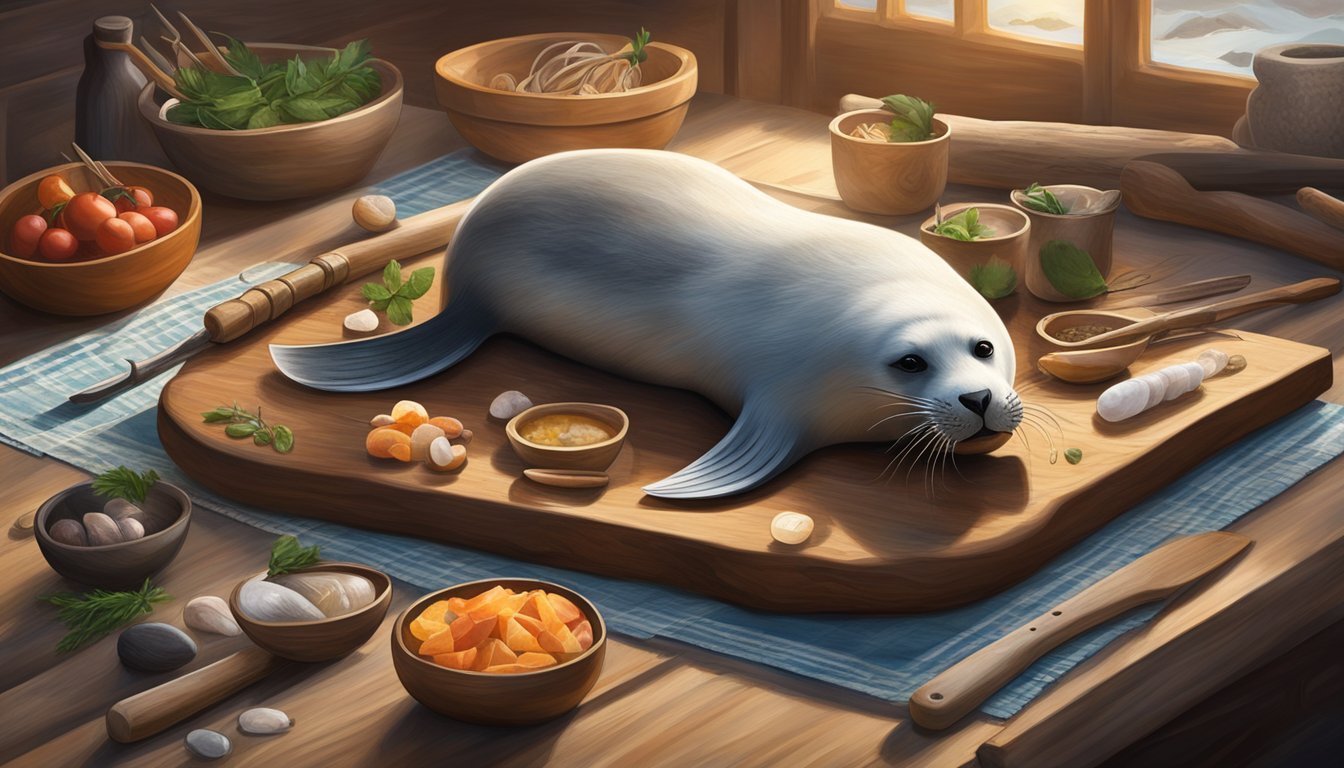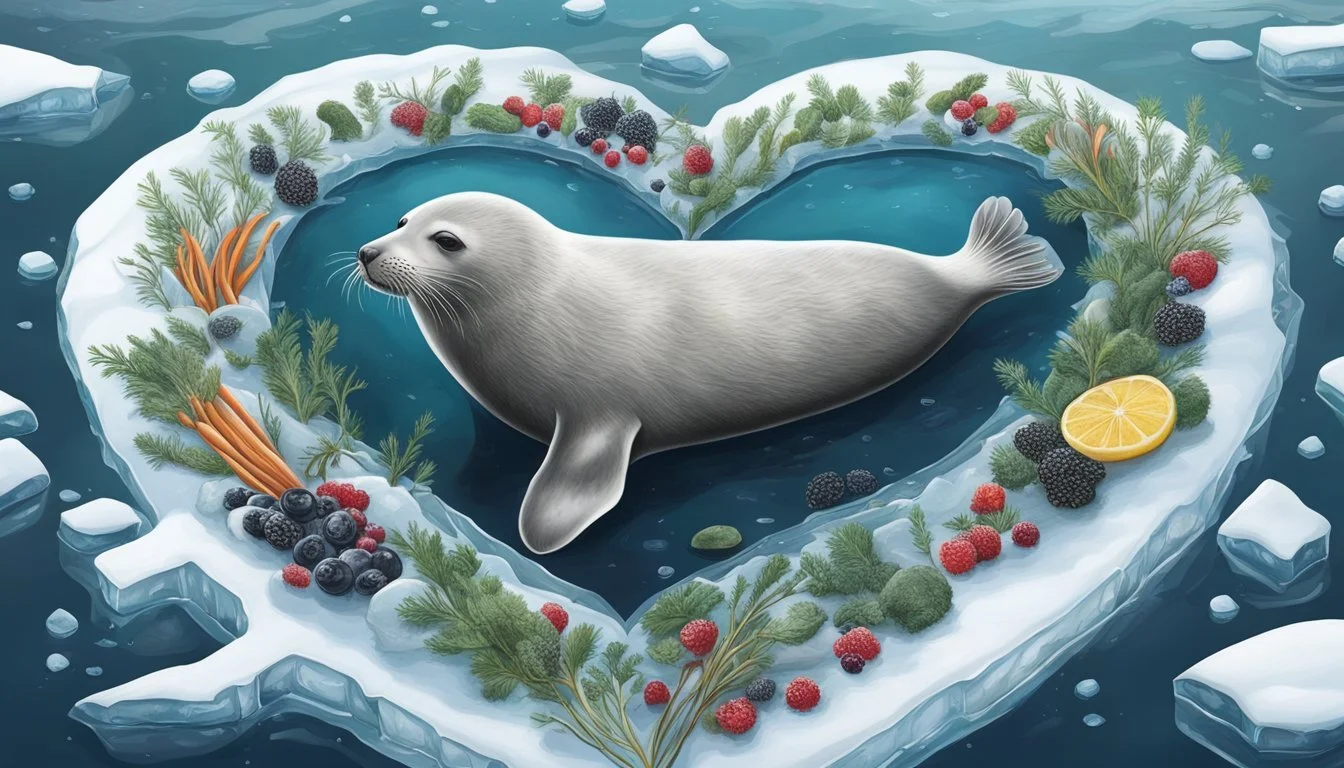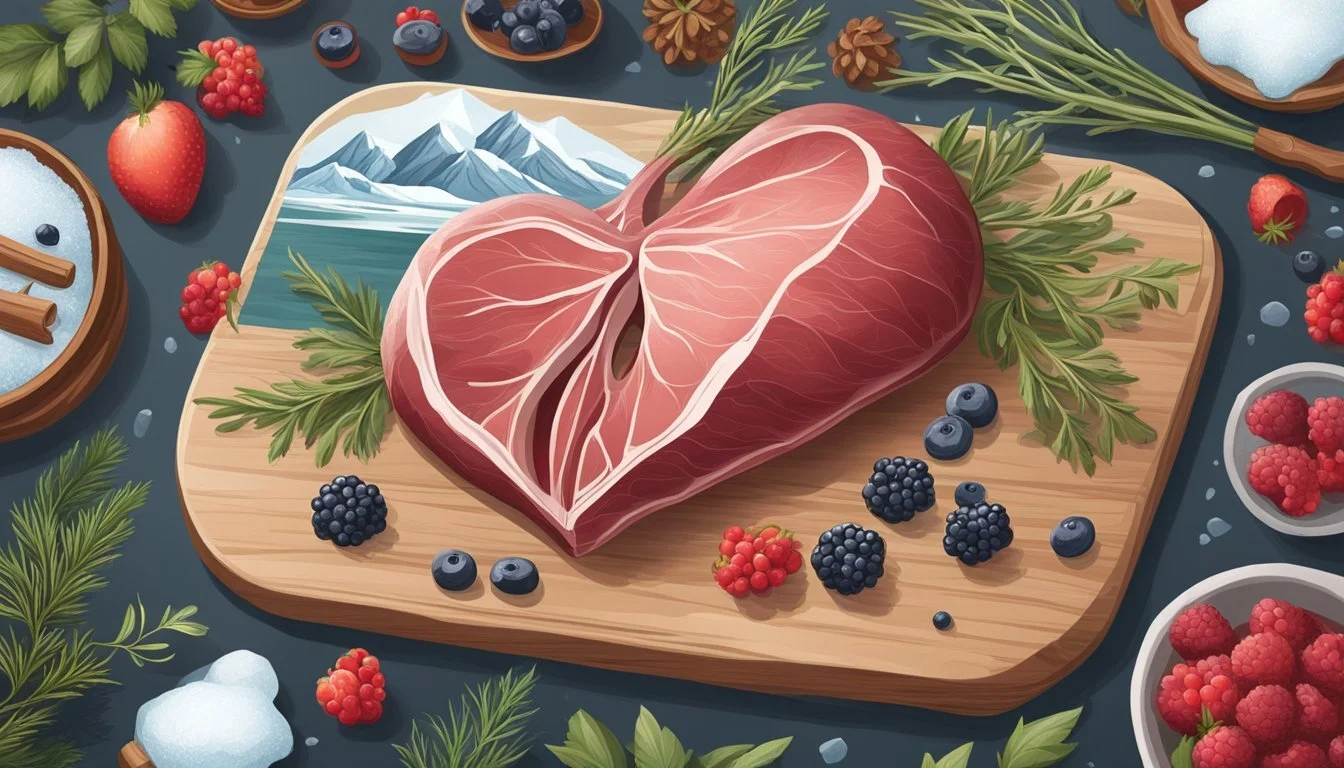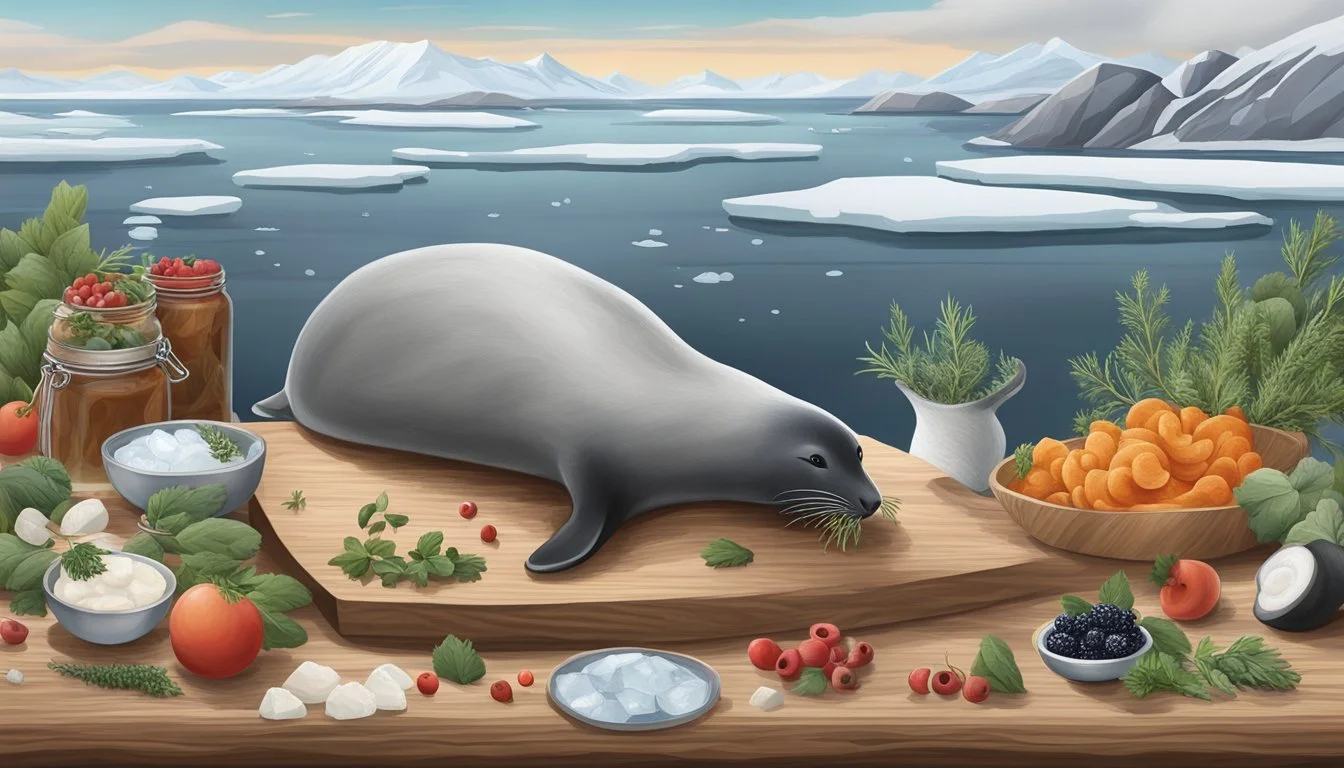Raw Seal Heart
Exploring the Traditions of Arctic Indigenous Foods
Arctic cuisine unfolds a narrative of survival, culture, and community tightly woven into the fabric of Inuit life. Among the many traditional dishes savored across the generations, raw seal heart stands out for its cultural significance and nutritional value. Central to Inuit culinary practices is the use of fresh, locally-sourced ingredients, reflecting an intimate connection with the land and sea that shape their daily existence. The consumption of raw seal heart is more than a matter of sustenance; it is a rite that honors the animal and reaffirms the deep relationship between the Inuit people and the harsh yet abundant Arctic environment.
This traditional diet is a direct insight into the resourcefulness of the Inuit, showcasing how Indigenous communities have ingeniously adapted to some of Earth's most extreme conditions. Rich in protein, fatty acids, and essential nutrients, the foods derived from hunting, like seal meat, are integral to their way of life. The practice of eating raw seal heart celebrates the directness of their cuisine, where the natural flavors and nutritional benefits are prioritized over complex cooking methods.
Providing a broader understanding of Inuit cuisine opens a window into the customs that have thrived in Arctic regions for millennia. As the Arctic undergoes environmental and socio-economic changes, maintaining such culinary traditions plays a vital role in preserving Inuit heritage. Through examining dishes like raw seal heart, one gains a greater appreciation for the resilience and adaptability inherent in the Indigenous cultures of the Arctic.
Historical Context of Indigenous Arctic Cuisine
The indigenous Arctic cuisine is deeply interwoven with Inuit cultural practices and has been reshaped by colonization and environmental legislation. Understanding these shifts is essential to appreciating the present-day culinary traditions of the Arctic Indigenous peoples.
Inuit Cultural Practices and Food Traditions
Inuit communities have cultivated food traditions that are closely tied to their nomadic lifestyle and the extreme climatic conditions of the Arctic. Country food, referring to natural foods found locally, such as seal, walrus, polar bear, and caribou, is central to Inuit culture. These traditions go beyond sustenance, representing social bonds, familial relationships, and cultural identity. Seal heart, for example, is not only prized for its nutritional value but also holds cultural significance, often being shared among community members.
Food sharing is a key aspect of Inuit customs, ensuring community cohesion and survival in harsh environments. The preparation methods, such as fermentation and raw consumption, have been passed down through generations, showcasing a distinct culinary heritage that emphasizes resourcefulness and respect for the land.
Effects of Colonization on Indigenous Diet
The imposition of European lifestyles and dietary habits during colonization profoundly affected the Indigenous food systems. Imported goods and the introduction of a money-based economy significantly altered local diets, as reliance on market-bought foods increased. Traditional hunting practices, which were once the cornerstone of survival, were impacted by the newly introduced governmental regulations and economic pressures, forcing some Inuit to adapt to a different way of life.
The disruption of traditional food networks also led to a decrease in the consumption of country food, with many Indigenous people moving toward convenient, often less nutritious, store-bought options. This shift has had lasting effects on the health and cultural continuity of Inuit communities.
Legal and Environmental Challenges
In recent times, Indigenous Arctic communities have faced legal and environmental challenges that threaten the continuity of their traditional food practices. Animal rights groups have advocated for bans on hunting practices deemed inhumane, often clashing with Indigenous rights to hunt for sustenance and maintain their cultural heritage.
The impact of climate change and pollution has also put pressure on the availability of traditional food sources, compounding the struggles of Indigenous peoples to secure food sovereignty. Legislative efforts, in partnership with Indigenous leaders, seek to balance the need for environmental protection with the rights of the Inuit to hunt and consume traditional foods central to their culture and survival.
Raw Seal Heart: A Delicacy in Detail
Raw seal heart is a significant element of Arctic cuisine, particularly valued by the Inuit for its nutritional benefits and role in their food traditions.
Nutritional Value and Health Benefits
The consumption of raw seal heart is rooted in a need for vital nutrients that are otherwise scarce in the Arctic environment. This organ is rich in iron and other minerals crucial for maintaining health, especially in the harsh Arctic climates. To quantify its nutritional impact, it is substantial in high-quality protein, which is essential for muscle repair and body function. As a traditional food source, the raw seal heart is also an excellent provider of vitamins, including a rare natural source of vitamin C in meat, which helps prevent scurvy—a concern for people in environments where plant-based sources of vitamin C are not readily available. Its fat content, while present, is rich in omega-3 fatty acids, known for their cardiovascular benefits.
Preparation Techniques and Culinary Uses
In Inuit culture, the preparation of raw seal heart is conducted with respect and ingenuity. It is typically consumed fresh and can be served as simple, unadorned slices, highlighting the natural flavors and textures revered by the community. The organ is carefully excised, and the freshness ensures the full spectrum of its nutritional benefits are intact. Culinary uses of seal heart within these communities are diverse, reflecting its integral place amongst traditional Inuit foods. It may be eaten alone or incorporated into stews, showcasing its versatility in traditional dishes. The methods of consuming this delicacy can serve as a testament to the Inuit's deep understanding and respect for their natural food resources.
Hunting and Sustainability
Hunting seals is integral to the culture and survival of Arctic Indigenous peoples, providing not only food but also materials for clothing and tools. Seal hunting practices developed over millennia are closely tied to sustainability and food security in these communities.
Traditional Inuit Hunting Methods
The Inuit employ age-old techniques when hunting seals, which are deeply rooted in their culture. Hunters often wait patiently by aglus (breathing holes) or use qamutiks (sleds) to traverse the ice in search of seals. The Inuktitut terms reflect a language rich in hunting vocabulary, signaling the practice’s central role in Indigenous culture. Traditional methods demonstrate a deep understanding of animal behavior and Arctic ecology, ensuring that seal populations remain stable.
Techniques:
Aglus monitoring
Use of qamutiks
Language & Culture:
Inuktitut terminology
Eco-centric cultural practices
Sustainable Practices and Food Security
Indigenous communities have historically managed seal populations with a focus on conservation and long-term ecosystem health. Their sustainable hunting practices aim to maintain seal numbers that support both the community's needs and the species' survival. Seals also play a role in managing food security, providing a nutrient-rich source of food that can help prevent deficiencies such as scurvy. Moreover, by hunting other animals like walrus and polar bear, these communities participate in a broader conservation effort that balances the predation pressure across different species.
Conservation Goals:
Protecting seal populations
Ensuring species survival
Nutrition & Health:
Nutrient-rich diet
Prevention of nutritional deficiencies
In summary, seal hunting by Indigenous Arctic communities embodies a sustainable approach that ensures food security and respects the delicate balance of their ecosystem.
Culinary Exploration of Seal Meat
Seal meat holds a place of prominence in Arctic indigenous cuisine, both in traditional dishes and modern gastronomy. Its significance is evident in the rich variety of preparations and the deep cultural heritage it embodies.
Contemporary Seal-Based Dishes
Seal meat is a versatile ingredient that features in a range of contemporary dishes, often reflecting the rich culinary tradition of the Inuit people. Highlighted by its high protein content, distinct umami flavor, and rich fatty acids, it offers nutritional value alongside its cultural significance. One popular preparation is seal meat stew, a comforting dish especially in Newfoundland and other Arctic regions. Stew usually combines tender seal meat with locally sourced vegetables and herbs, creating hearty and nourishing meals.
Appetizers also make use of seal meat, particularly as a means to introduce diners to its unique taste. A modern twist might present thinly sliced seal meat akin to sushi, capitalizing on its freshness and subtle flavors. This method also aligns with the sustainable principles of utilizing game meats, making the most of the whole animal in a manner that is respectful and environmentally conscious.
Seal Meat in Modern Gastronomy
Within modern gastronomy, seal meat has emerged as an intriguing alternative to traditional proteins like cows. Restaurants specializing in Arctic cuisine or experimental dining might showcase dishes like seal maktaaq, which comprises the skin and blubber of the seal and is sometimes served in the form of muktuk—a traditional dish that includes the skin and blubber of narwhal or beluga.
As culinary professionals pursue innovation, they also preserve integrity, often freeze seal meat to ensure the quality and safety is maintained. The contemporary culinary applications of seal meat encompass borrowing from traditional practices, like aging or fermenting, to elevate its flavor profile. Arctic char, another staple of Arctic cuisine, is sometimes paired with seal meat to create a symphony of regional flavors that are both old and new.
These are not just experiments; they represent a fusion of past and present—a commitment to culinary tradition while embracing evolution and exposure to a wider food audience.
Arctic Food Sources Beyond Seal
The indigenous Arctic diet is rich and varied, composed of numerous animals and plants that thrive in the frigid climate, providing essential nutrients to the communities that harvest them.
Diverse Game and Marine Life
Game Meat: Indigenous Arctic residents traditionally harvest a variety of game animals. This includes caribou, which is central to the subsistence lifestyle of many northern peoples. Caribou is valued for its lean, protein-rich meat. The hunting and consumption of birds such as ptarmigan are also integral, as these birds are plentiful and accessible throughout the year.
Marine Life: The icy waters of the Arctic are home to a wide range of marine animals. Fish such as Arctic char and various species of salmon are prevalent food sources. In addition, marine mammals like narwhal, with its coveted tusk and rich meat, and beluga, appreciated for its meat and blubber, constitute a vital part of the diet. Whale blubber, often from bowhead whales, is another traditional staple, revered for its dense energy content.
Plant-Based Additions and Alternatives
While the Arctic is not known for its abundance of plant life, indigenous peoples have traditionally gathered what is available to complement their diet.
Berries: Across the tundra, various berries emerge during the brief summer months, bursting with vitamins. Cloudberries, crowberries, and other regional fruits such as blueberries are collected and savored fresh or preserved for the long winter ahead.
The use of plants is seasonally dependent, with the very limited growing season dictating availability. The traditional diet harnesses these nutritious food sources for both immediate consumption and preservation for the scarcer times of the year.
Cultural Significance of Sharing and Gastronomy
Within Indigenous Arctic communities, the sharing of food is not just an act of sustenance but a profound expression of culture and connection. The gastronomy of the Arctic is rich with traditional dishes that are both a testament to the harsh environment and a celebration of its bounty.
The Role of Food in Inuit Social Structures
Inuit social structures are deeply intertwined with the act of sharing food, which is considered a fundamental practice. The ulu, a traditional all-purpose knife, often wielded by women, is a symbol of this sharing. It is used to prepare meals that are then shared among family and community members, reinforcing social bonds and ensuring collective survival. Sharing is indicative of a person's status within the community, as it reflects one's ability to provide. Traditional foods like raw seal heart are high in essential fatty acids, minerals, and zinc, contributing greatly to the nutritional needs of the community.
Minerals such as calcium: Found in high quantities in seal meat, which benefits bone strength and development.
Fatty acids: Present in the seal are crucial to health, especially in the cold climate of the Arctic.
Indigenous Arctic gastronomy emphasizes a respectful and mindful approach to the environment, with communities taking only what is needed and using every part of an animal.
Festivals and Culinary Events Highlighting Indigenous Dishes
Festivals and culinary events are a platform where the richness of Indigenous Arctic cuisine is showcased, and the practice of sharing is celebrated on a larger scale. The Taste of the Arctic is one such event where one can immerse themselves in the culinary adventure, savoring dishes that are composed of notable ingredients such as musk ox and other locally sourced, nutrient-rich foods. These events highlight the vibrant food traditions and allow for cultural exchange, as visitors and community members alike partake in the feast.
- Festivals celebrate the dual roles of food as both necessity and art, providing insight into the culture and history of Indigenous Arctic peoples.
Culinary events are not only a showcase of traditional foods but are also an opportunity to maintain and pass down important cultural knowledge and practices, ensuring that they continue to thrive in modern times.
Inuit Innovation and Adaptation
In an era where tradition confronts change, the Inuit are finding ways to blend the old with the new, ensuring their cuisine adapts without losing its essence.
Incorporating Modern Techniques and Flavors
Inuit Cuisine has traditionally been centered on what the harsh Arctic environment could provide, such as seal. Yet, as access to global ingredients has increased, so has the incorporation of diverse flavors. One such example is the introduction of soy sauce into the preparation of raw seal heart, which adds an umami flavor highly regarded by both locals and the adventurous palates of outsiders. This fusion approach has led to a smoked variant of the seal heart, appealing to a broader demographic, including diners in metropolitan areas like Vancouver.
In addition to flavor innovation, Inuit communities on Baffin Island have started to integrate modern techniques that reflect a broader transformation. The melding of contemporary smoking methods and traditional drying processes results in a jerky-style preparation that is both portable and preserves the food, helping to tackle food insecurity issues in remote areas.
Challenges and Opportunities for Indigenous Arctic Cuisine
While adapting their culinary practices, the Inuit face the continuous challenge of climate change. The melt of traditional hunting grounds has necessitated shifts in food sourcing, with some communities establishing small-scale farms to supplement their diets. This adaptation not only provides additional food sources like vegetables but also introduces new culinary elements into the traditional diet.
The preservation and innovation within Inuit cuisine present numerous opportunities. In regions such as Newfoundland, traditional foods like duck are transformed into modern delicacies, combining methods like smoking with indigenous practices. These practices offer a culinary bridge between past and present and pave the way for unique food items, like smoked duck, that can alleviate food insecurity by increasing variety and availability.
Arctic gastronomy stands at a crossroads where community resilience shines through culinary innovation. The Inuit continue to creatively adapt their time-honored dietary customs, creating a dynamic food culture that respects tradition while embracing change.
Activism and Global Perceptions
The portrayal of Indigenous culinary traditions, such as the consumption of raw seal heart, often ignites debates around animal rights and illuminates the impact of global media narratives.
The Intersection of Animal Rights and Indigenous Ways
Animal rights organizations have frequently critiqued the harvest of game meats like seal, polarizing public opinion. Greenpeace, once known for opposing the seal hunt, has publicly regretted the impact of its campaigns on Indigenous communities. Indigenous peoples argue their hunt is conducted sustainably and is embedded in their cultural practices. They assert that traditional harvesting rights must be recognized alongside animal welfare.
In Ottawa, the capital of Canada, these discussions often resonate within political spheres. Legislation and food policies are influenced by activists' rhetoric, whether supporting animal rights or defending Indigenous sovereignty over traditional food practices.
Media and Documentary Influence
The CBC documentary "Angry Inuk" has been pivotal in re-framing the narrative around seal hunting. It presents the Indigenous perspective on seal hunting, countering the often one-sided portrayal by international media and activists.
The film showcases how Inuit communities depend on seal and other game meats for survival, highlighting their respectful hunting traditions. The documentary's impact has reached a global audience, challenging misconceptions and urging a re-evaluation of Indigenous food practices in the context of modern activism.
Language of the Land: Inuktitut and Food
Inuit heritage and identity in the Arctic are inextricably tied to the Inuktitut language and traditional food practices. These elements of culture not only provide sustenance but also serve as a means of communication and preservation of traditions from generation to generation.
Inuktitut Terminology in Arctic Cuisine
Inuktitut, the language of the Inuit people, deeply reflects their intimate relationship with the environment and their food. Each ingredient and dish in Arctic cuisine is named in Inuktitut, illustrating its importance within their culture. For instance, tirigusuusiit refers to the culturally significant caribou, while misiraq is the word for fermented seal oil, a key flavor enhancer in many dishes. Raw seal heart, known as arḷaq, is not just a source of nourishment but also a symbol of connection to the land and sea. Inuktitut names often convey much more than the item itself, encapsulating the significance and stories behind the food.
The Preservation of Language Through Culinary Arts
Culinary practices play a crucial role in maintaining the Inuktitut language. As recipes and techniques for preparing traditional dishes like raw seal heart are passed down, so too is the language. Each cooking method, tool, and ingredient carries with it an Inuktitut term, fortifying the vocabulary with every use. Traditional food gatherings are also times when Inuktitut is spoken and taught, ensuring that the language remains vibrant. Through the continuity of culinary traditions, the Inuktitut language perseveres, sustaining the societal fabric and cultural identity of the Inuit people.
The Future Landscape of Inuit Cuisine
The Inuit cuisine's future is shaped by the intersection of cultural preservation and modern innovation, with global partnerships fostering its growth and sustainability.
Global Partnerships and Indigenous Advocacy
The Inuit Tapiriit Kanatami (ITK) plays a pivotal role in the global partnerships that are core to the evolution of Inuit cuisine. These alliances promote indigenous advocacy, ensuring that Inuit communities in regions like Arctic Bay have a voice in international forums. Partnerships with grocery stores and food programs are crucial in tackling the high cost of imported food by facilitating access to traditional, nutrient-rich dishes (What wine goes well with rich dishes?) that hold cultural significance. The ITK's advocacy work aids in preserving the Inuit lifestyle and food sovereignty while striving for equitable access to traditional foods across global markets.
Innovation and Revitalization of Traditional Dishes
Inuit cuisine is experiencing a renaissance through the innovation and revitalization of traditional dishes. This culinary reinvention includes experimenting with cooking techniques and presentations while remaining rooted in the essence of the heritage.
Traditional seal meat, for instance, is being re-introduced in novel ways that appeal to a broader audience, integrating it into contemporary recipes that highlight its nutritional value.
Technological advancements in food preservation and distribution are empowering Inuit communities to expand their reach, allowing for regional dishes to be shared with new demographics.
This transformative era for Inuit cuisine is characterized by a blend of ancestral knowledge and modern culinary practices, ensuring its rightful place in the global gastronomic landscape.
Key Ingredients in Detail
The preparation of raw seal heart in indigenous Arctic cuisine often involves a deep understanding of each ingredient's role and an ethos of utilizing all parts of the animal to avoid waste. This respect for natural resources is critical to the culture and survival in the Arctic environment.
Understanding the Role of Blubber
Blubber, primarily derived from seals, is a crucial component in indigenous Arctic cuisine. This layer of fat beneath the seal's skin serves multiple purposes. It provides insulation to the animal and when consumed by humans, it offers a dense source of energy and nutrients, essential for surviving the harsh Arctic climate. Narwhal blubber is also consumed and holds a similar cultural significance. While seal oil, rendered from this fat, is a traditional source of heat and light.
Nutritional Content: Blubber contains vitamins A, D, E, and omega-3 fatty acids.
Uses: Aside from consumption, blubber is transformed into oil for lamps and heating, showcasing the multifaceted uses of this ingredient.
Utilizing All Parts: From Bones to Blubber
Indigenous peoples utilize the entire animal in their cuisine; nothing is wasted. Seal bones are crafted into tools and weapons. Seal meat includes not just the flesh but also the heart, highly prized for its flavor and texture. Aside from seal, caribou and bowhead whale meat are also integral, with the latter especially respected — some populations of bowhead whales are considered endangered, and thus are harvested in a regulated fashion according to traditional and conservation laws.
Seal Heart: Consumed raw, rich in iron and zinc.
Bone Uses: Tools, utensils, and artistic carvings.
The careful and sustainable use of these ingredients reflects indigenous Arctic peoples' respect for the animals they depend on, ensuring that their culture and the environment can coexist harmoniously.











